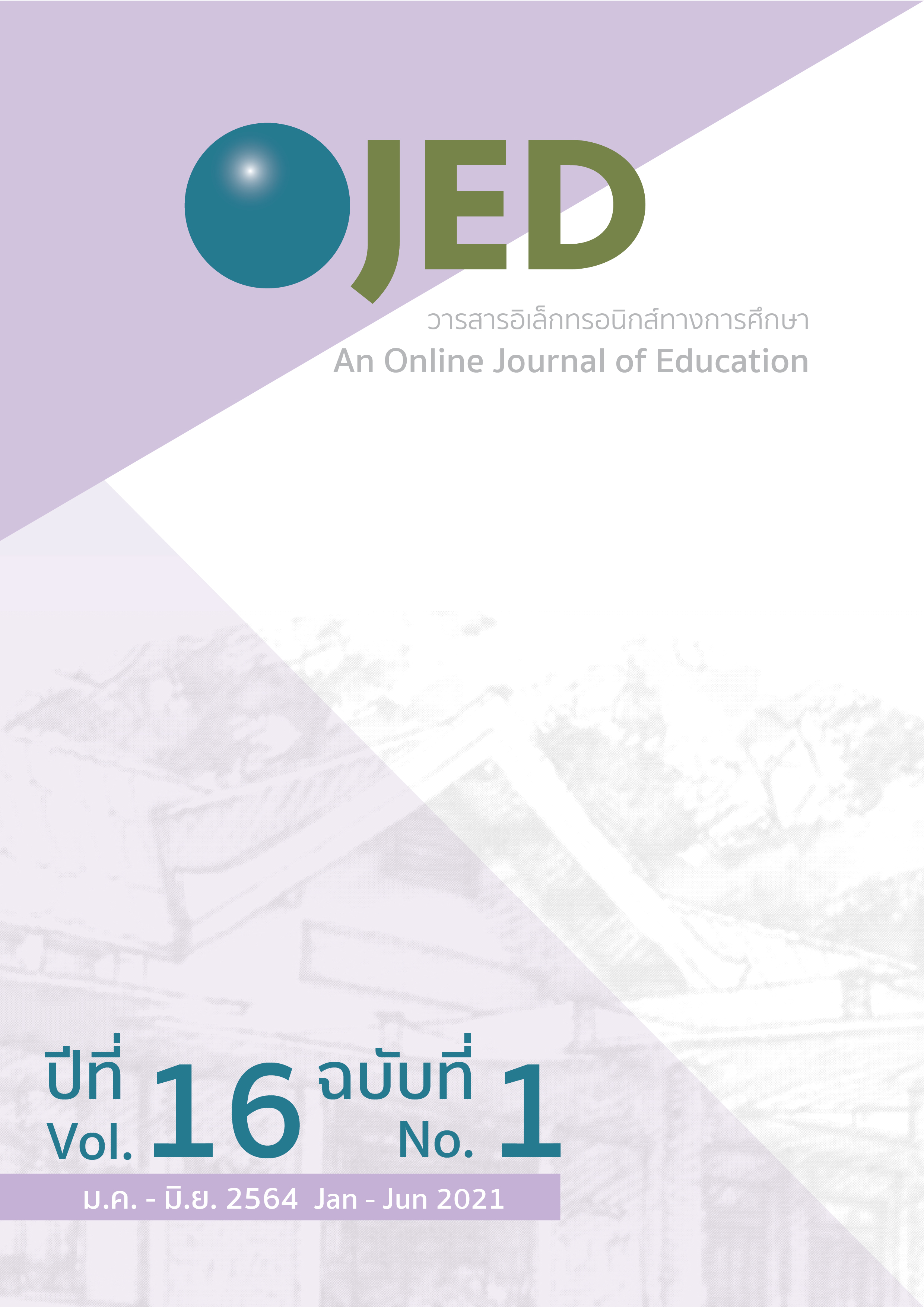Effects of Thai Sword Training Program based on Guilford’s Concept upon Creative Thinking Higher Education Students
DOI:
https://doi.org/10.14456/ojed.2021.6Keywords:
Thai sword, Guilford, creative thinkingAbstract
The purpose of this study was to examine the effects of a Thai sword training program based on Guildford’s concept of creative thinking among higher education students. Thirty-eight students from the Physical Education Institute were divided into two groups, the Experimental group (n = 19) and the Control group (n = 19). In the experimental group, the participants were trained using the adapted Thai Sword Training Program for 60 minutes per day, 3 days per week for a total of 8 weeks. The research instruments included the Thai Sword Training Program consisting of eight practice platforms and adapted creative thinking assessments. Data was analyzed using mean score, standard derivative, and t-test. The findings were as follows: 1) After comparing the pre-test and post-test scores, the mean score of creative thinking in the experimental group was higher (p < .05); 2) there was no difference between the pre-test and post-test average scores for creative thinking in the control group; 3) when comparing the experimental and control groups, the pre-test and post-test scores were not different. In conclusion, the Thai sword training program based on Guildford’s concept of creative thinking is found to improve creative thinking in Thai sword sports.
References
กัลยา อัมพปฏิภาค. (2547). การส่งเสริมให้นักเรียนคิดอย่างสร้างสรรค์. วารสารการศึกษาวิทยาศาสตร์
คณิตศาสตร์ เทคโนโลยี. 33(132), 10-13.
กรมวิชาการ. (2534). เอกสารเพื่อการพัฒนาหนังสืออันดับ 1 การพัฒนาสื่อการเรียนการสอน. การศาสนากรมการศาสนา
กระทรวงการท่องเที่ยวและกีฬา. (ม.ป.ป.). ยุทธศาสตร์สถาบันการพลศึกษา (มหาวิทยาลัยการกีฬาแห่งชาติ) พ.ศ.2561-2565. http://www.tnsu.ac.th/web/web2/images/fbfiles/62/กลุ่มนโยบายและยุทธศาสตร์/ยุทธศาสตร์สถาบันการพลศึกษา (มหาวิทยาลัยการกีฬาแห่งชาติ).pdf
เกรียงศักดิ์ เจริญวงศ์ศักดิ์. (2545). การคิดเชิงสร้างสรรค์. ซัคเซสมีเดีย.
ดุษดี สุขสวัสดิ์. (2539). การศึกษาความสัมพันธ์ระหว่างความคิดสร้างสรรค์กับผลสัมฤทธิ์ทางการเรียน
วิชาพลศึกของนักเรียนมัธยมศึกษาปีที่ 3 ในโรงเรียนมัธยมศึกษา [วิทยานิพนธ์ปริญญามหาบัณฑิต ไม่ได้ตีพิมพ์]. จุฬาลงกรณ์มหาวิทยาลัย.
ประพันธ์ศิริ สุเสารัจ. (2551). การพัฒนาการคิด. โรงพิมพ์ห้างหุ้นส่วนจำกัด 9119 เทคนิคพริ้นติ้ง.
ประยุกต์ บุนนาค. (2556). ตำแหน่งกระบี่กระบอง. สารคดี, 19(2).
พงศ์ภัทร ธนะสินธนา, ภัทรา ธรรมดาตระกูล และ หิรัญญา คะตา. (2556). การพัฒนาโปรแกรมการสอน
ความคิดสร้างสรร์โดยใช้เทคนิคการคิดหน่วยภาษาแบบอเนกนัยตามแนวคิดของกิลฟอร์ด [โครงงาน]
จุฬาลงกรณ์มหาวิทยาลัย.
พรรณี เกษกมล. (2534). การพัฒนาความคิดสร้างสรรค์. สารพัฒนาหลักสูตร, 11(107), 75-78.
ไพฑูรย์ สินลารัตน์. (2546). อุดมศึกษาไทยในอุดมศึกษาโลก. ศูนย์ตำราคณะครุศาสตร์
จุฬาลงกรณ์มหาวิทยาลัย.
เมริกา ตรรกวาทการ. (2558). ผลของการใช้ชุดกิจกรรมส่งเสริมทักษะการคิดสร้างสรรค์ของนักเรียน
ชั้นประถมศึกษา [วิทยานิพนธ์ปริญญามหาบัณฑิต ไม่ได้ตีพิมพ์]. จุฬาลงกรณ์มหาวิทยาลัย.
วัฒนา ไตรรัตน์. (2551). ครูดาบในดวงใจ ทองหล่อ ไตรรัตน์. ใน อนุสรณ์งานพระราชทานเพลิงศพ
เป็นกรณีพิเศษ นายทองหล่อ ไตรรัตน์ (9 มีนาคม). ม.ป.ท.
ศิลปชัย สุวรรณธาดา. (2533). กุศโลบายจินตภาพ: หลักการฝึก. สงวนกิจการพิมพ์.
สมบูรณ์ อินทร์ถมยา. (2550). หลักการสอนและการฝึกกีฬา [เอกสารที่ไม่ได้ตีพิมพ์]. คณะครุศาสตร์
จุฬาลงกรณ์มหาวิทยาลัย.
สุพัตรา ทาวงศ์. (ม.ป.ป.). ความคิดสร้างสรรค์ (Creative thinking). http://dspace.spu.ac.th/bitstream/
123456789/1040/1/ความคิดสร้างสรรค์.doc
สถาบันการพลศึกษา. (2559). สถาบันการพลศึกษา กระทรวงการท่องเที่ยวและกีฬา.
http://113.53.231.197/web/web3
สมาคมกีฬากีฬาไทยแห่งประเทศไทย ในพระบรมราชูปถัมภ์. (2559) ข้อบังคับสมาคมกีฬากีฬาไทยแห่งประเทศไทย ในพระบรมราชูปถัมภ์ ว่าด้วย กติกาการแข่งขันกีฬาดาบไทย พ.ศ. 2559. https://thaisports.org/กติกาการแข่งขันกีฬาดาบ/
สำนักงานคณะกรรมการการศึกษาแห่งชาติ. (2540). เอกสารประกอบการประชุมกลุ่มทักษะคณิตศาสตร์ ปี
2540. คอมฟอร์ม.
อารี พันธ์มณี. (2540). ความคิดสร้างสรรค์กับการเรียนรู้. คอมแพคท์พริ้น.
ภาษาอังกฤษ
Divito, A. (1971). Recognized assessing creativity developing teacher competencies. Prentice-Hall
Guilford, J. P. (1967). The Nature of Human Intelligence. McGraw-Hill Book.
Jellen, H. & Urban, K.K. (1986). The TCT-DP (Test for creative thinking - Drawing production): An instrument that can be applied to most age and ability groups. Creative Child and Adult Quarterly, 11, 138-155.
Downloads
Published
How to Cite
Issue
Section
License

This work is licensed under a Creative Commons Attribution-NonCommercial-NoDerivatives 4.0 International License.




